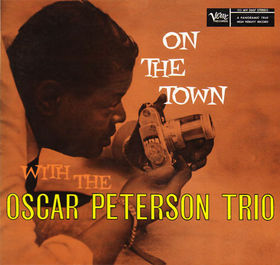
Coleman Randolph Hawkins, nicknamed "Hawk" and sometimes "Bean", was an American jazz tenor saxophonist. One of the first prominent jazz musicians on his instrument, as Joachim E. Berendt explained: "there were some tenor players before him, but the instrument was not an acknowledged jazz horn". Hawkins biographer John Chilton described the prevalent styles of tenor saxophone solos prior to Hawkins as "mooing" and "rubbery belches." Hawkins cited as influences Happy Caldwell, Stump Evans, and Prince Robinson, although he was the first to tailor his method of improvisation to the saxophone rather than imitate the techniques of the clarinet. Hawkins' virtuosic, arpeggiated approach to improvisation, with his characteristic rich, emotional, and vibrato-laden tonal style, was the main influence on a generation of tenor players that included Chu Berry, Charlie Barnet, Tex Beneke, Ben Webster, Vido Musso, Herschel Evans, Buddy Tate, and Don Byas, and through them the later tenormen, Arnett Cobb, Illinois Jacquet, Flip Phillips, Ike Quebec, Al Sears, Paul Gonsalves, and Lucky Thompson. While Hawkins became known with swing music during the big band era, he had a role in the development of bebop in the 1940s.

Jean-Baptiste "Illinois" Jacquet was an American jazz tenor saxophonist, best remembered for his solo on "Flying Home", critically recognized as the first R&B saxophone solo.

Harry "Sweets" Edison was an American jazz trumpeter and a member of the Count Basie Orchestra. His most important contribution was as a Hollywood studio musician, whose muted trumpet can be heard backing singers, most notably Frank Sinatra.

Jazz at the Philharmonic, or JATP (1944–1983), was the title of a series of jazz concerts, tours and recordings produced by Norman Granz.

Mitchell Herbert Ellis, known professionally as Herb Ellis, was an American jazz guitarist. During the 1950s, he was in a trio with pianist Oscar Peterson.

James Charles Heard was an American swing, bop, and blues drummer.

At the Opera House is a 1958 live album by Ella Fitzgerald. The album presents a recording of the 1957 Jazz at the Philharmonic Concerts. This series of live jazz concerts was devised by Fitzgerald's manager Norman Granz; they ran from 1944 to 1983. Featured on this occasion, in 1957, are Fitzgerald and the leading jazz players of the day in an onstage jam session. The first half of the 1990 CD edition includes a performance that was recorded on September 29, 1957, at the Chicago Opera House, whilst the second half highlights the concert recorded on October 7, 1957, at the Shrine Auditorium, in Los Angeles. The original LP obviously included only the mono tracks (#10-18).

Jonathan David Samuel Jones was an American jazz drummer. A band leader and pioneer in jazz percussion, Jones anchored the Count Basie Orchestra rhythm section from 1934 to 1948. He was sometimes known as Papa Jo Jones to distinguish him from younger drummer Philly Joe Jones.
Discography for jazz double-bassist and cellist Ray Brown.

Blossom Dearie is an album by Blossom Dearie that was recorded in 1956 and released in 1957. It was her first recording for Verve.
Alvin Stoller was an American jazz drummer. Though he seems to have been largely forgotten, he was held in high regard in the 1940s and 1950s. He was best known for playing drums on both Mitch Miller's recording of "The Yellow Rose of Texas" and Stan Freberg's parody of Miller's recording.
Black & Blue Records was a record company and label founded in France in 1968 that specialized in blues and jazz.

On the Town with the Oscar Peterson Trio is a live album by jazz pianist Oscar Peterson, released in 1958.

The Oscar Peterson Trio with Roy Eldridge, Sonny Stitt and Jo Jones at Newport is a 1957 live album by Oscar Peterson, accompanied by Roy Eldridge, Sonny Stitt and Jo Jones, recorded at the 1957 Newport Jazz Festival.

Krupa and Rich is a 1956 studio album by jazz drummers Gene Krupa and Buddy Rich, released on Norman Granz' Clef Records. Krupa and Rich play on two different tracks each and play together only on "Bernie's Tune." Krupa and Rich would record again for Verve Records; their album Burnin' Beat was released in 1962.

Little Jazz is an album by American jazz trumpeter Roy Eldridge recorded in 1954 and originally released on the Clef label. "Little Jazz" was Roy Eldridge's nickname.

Roy and Diz is an album by trumpeters Roy Eldridge and Dizzy Gillespie, recorded in 1954 and originally released on the Clef label as two separate volumes. Selections from these sessions were also released as Trumpet Battle and The Trumpet Kings.

Groovin' with Jacquet is an album by American jazz saxophonist Illinois Jacquet, recorded in 1951 and late 1953 and released on the Clef label.

Dale's Wail is an album by American jazz trumpeter Roy Eldridge recorded in 1953 and originally released on the Clef label.

Rockin' Chair is an album by American jazz trumpeter Roy Eldridge recorded in 1951 and 1952 and originally released on the Clef label.

















